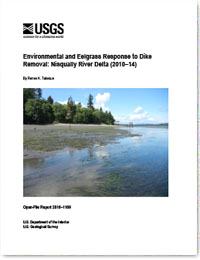Environmental and eelgrass response to dike removal: Nisqually River Delta (2010–14)
Links
- Document: Report (3.9 MB pdf)
- Download citation as: RIS | Dublin Core
Abstract
Restoration of tidal flows to formerly diked marshland can alter land-to-sea fluxes and patterns of accumulation of terrestrial sediment and organic matter, and these tidal flows can also affect existing nearshore habitats. Dikes were removed from 308 hectares (ha) of the Nisqually National Wildlife Refuge on the Nisqually River Delta in south Puget Sound, Washington, in fall 2009 to improve habitat for wildlife, such as juvenile salmon. Ecologically important intertidal and subtidal eelgrass (Zostera marina) beds grow on the north and west margins of the delta. The goal of this study was to understand long-term changes in eelgrass habitat and their relation to dike removal. Sediment and eelgrass properties were monitored annually in May from 2010 to 2014 at two sites on the west side of the Nisqually River Delta along McAllister Creek, a spring-fed creek near two restored tidal channels. In May 2014, the mean canopy height of eelgrass was the same as in previous years in an 8-ha bed extending to the Nisqually River Delta front, but mean canopy height was 20 percent lower in a 0.3-ha eelgrass bed closer to the restored marsh when compared to mean canopy height of eelgrass in May 2010, 6 months after dike removal was completed. Over 5 years, the amount of eelgrass leaf area per square meter (m2) in the 8-ha bed increased slightly, and surface-sediment grain size became finer. In contrast, in the 0.3-ha bed, eelgrass leaf area per m2 decreased by 45 percent, and surface sediment coarsened. Other potential stressors, including sediment pore water reduction-oxidation potential (redox) and hydrogen sulfide (H2S) concentration in the eelgrass rhizosphere, or root zone, were below levels that negatively affect eelgrass growth and therefore did not appear to be environmental stressors on plants. Eelgrass biomass partitioning, though less favorable in the 8-ha eelgrass bed compared to the 0.3-ha one, was well above the critical above-ground to below-ground biomass ratio of 2:1 for Z. marina, an indication that these plants were not at risk of a carbon deficit during low-light conditions. After 5 years, nearshore changes associated with the restoration of tidal flows to formerly diked marshes of the Nisqually River Delta appeared to have little impact on the large eelgrass bed extending from Luhr Beach to the Nisqually River Delta front; however, restoration appears to be contributing to the decline of a small eelgrass bed closer to the restoration area.
Suggested Citation
Takesue, R.K., 2016, Environmental and eelgrass response to dike removal: Nisqually River Delta (2010–14): U.S. Geological Survey Open-File Report 2016–1169, 17 p., https://dx.doi.org/10.3133/ofr20161169.
ISSN: 2331-1258 (online)
Study Area
Table of Contents
- Abstract
- Introduction
- Methods
- Results
- Summary
- References Cited
- Appendixes 1–3
| Publication type | Report |
|---|---|
| Publication Subtype | USGS Numbered Series |
| Title | Environmental and eelgrass response to dike removal: Nisqually River Delta (2010–14) |
| Series title | Open-File Report |
| Series number | 2016-1169 |
| DOI | 10.3133/ofr20161169 |
| Publication Date | October 03, 2016 |
| Year Published | 2016 |
| Language | English |
| Publisher | U.S. Geological Survey |
| Publisher location | Reston, VA |
| Contributing office(s) | Pacific Coastal and Marine Science Center |
| Description | vi, 17 p. |
| Country | United States |
| State | Washington |
| Other Geospatial | Nisqually River Delta |
| Online Only (Y/N) | Y |


